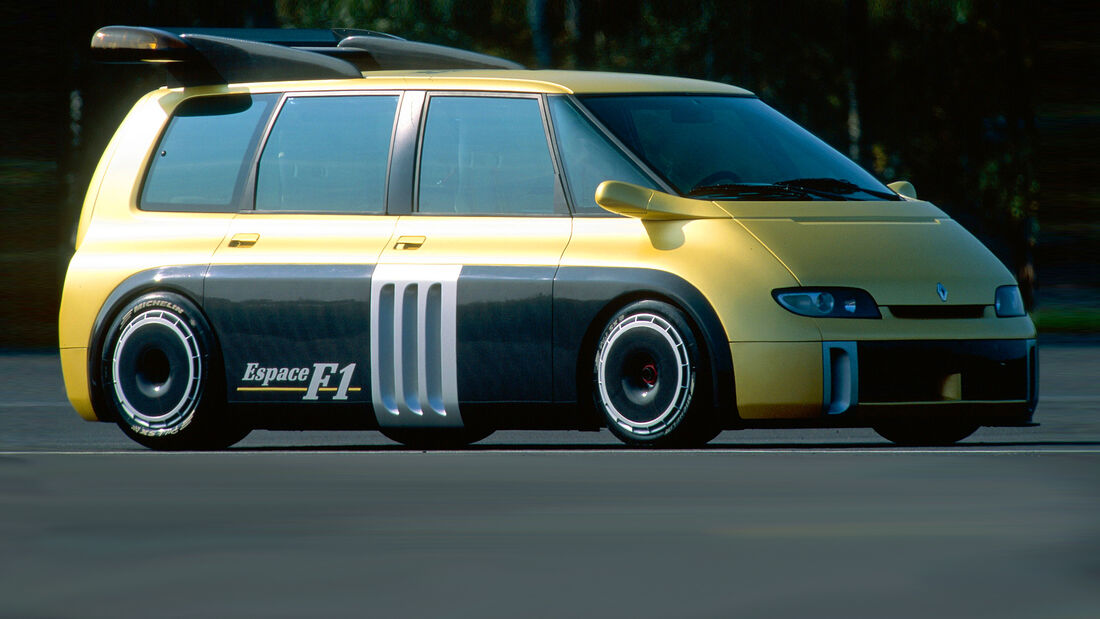Renault Espace can do a lot, for example, equip a large family and take them on a relaxing vacation. But acceleration to 100 km/h is the same speed as a current Porsche 911 GT2 RS with 700 hp, a McLaren 765LT with 765 hp, or a Lamborghini Aventador SVJ with 770 hp? This may sound silly, but the Espace can run just as fast. And exactly one.
The story is now a quarter century old, and seems made up, but it actually happened. In the mid-nineties, Renault, the Williams Formula 1 team and the French company Matra, which mass-produced the Espace, turned the family van into a real monster. Externally and technically. Designer Gérard Ducarouge was responsible for the project.
In this photo you can see the intake horns of the V10 engine.
The V10 has a seat angle of 67 degrees
Williams and Renault have been working together in Formula 1 since 1989. The English built the chassis of racing cars and paid attention to mechanics and aerodynamics. The French contributed to the engine. For the Espace's tenth anniversary in 1994 – and after three consecutive joint Formula 1 titles – the partners created a unique piece based on a carbon chassis and containing a ten-cylinder engine.
The interior has been cleaned and fitted with four carbon bucket seats. The intake horns of the 3.5-liter naturally aspirated V10 engine can be seen in the press photos between the two rear seats – they make you click your tongue! The V10 engine places the two cylinder banks at a 67-degree angle. Here is an overview of the basic data of a Formula 1 engine:
- Type: V10
- Cylinder angle: 67 degrees
- Displacement: 3,498 cc
- Bore * Stroke: 96.0*48.3mm
- Valves: 40
- Valve train: 4 overhead camshafts, opening and closing valves pneumatically
- Valve control: spur gear motor
- Performance: 790 hp at 14,700 rpm
- Compression: 12.6:1
- Weight: 135 kg
- Dimensions (L*W*H): 620*530*411 mm
- Electricity: Magneti Marelli
In the Espace prototype, the 40-valve engine in mid-engine mode produces 811 hp and develops a maximum torque of 705 Nm, according to Renault. Adjust a little. Transmission is handled by a Williams six-speed semi-automatic transmission. It is located behind the engine in the trunk. The driver changes gears using the buttons on the steering wheel.
As wide as a barn door, but incredibly fast: the Renault Espace F1.
Risk of acute fatigue
Passengers are subjected to crazy driving performance. The Espace F1, which weighs around 1.1 tons, is not only supposed to hit 100 something in less than three seconds, it's also supposed to break the 200 something mark in less than seven seconds. Various information is available about the maximum speed. It is sometimes said that a Formula 1 Espace car can reach speeds of around 300 km/h. Other sources talk about a speed of more than 310 km/h.
Despite traction control, there is a serious risk of fatigue. The driver must gently press the accelerator pedal, otherwise there is a risk of spinning. With slick Michelin tires measuring 27cm wide at the front and 36cm at the rear, this unique piece is said to have generated lateral g-forces of up to 2g when cornering.
This also requires aerodynamic changes. The front of the car has enlarged air intakes with an integrated front spoiler. There is a diffuser on the back. Half of the roof is covered by a large spoiler that generates downforce. Gears in the trunk, wings on the roof: holiday luggage had to stay at home.
Renault Espace F1 with a naturally aspirated V10 engine
1:09 minutes
160 dB indoors
The images reveal that the Espace has also been taken down. Sure enough, the engineers also completely retuned the suspension, springs and dampers. Carbon fiber brake discs, 355mm in diameter at the front and 280mm at the rear, slow the truck down rigorously.
Huge nostrils open in the driver and passenger doors. They may be used for ventilation. However, the naturally aspirated V10 warms up the occupants. There is talk of temperatures exceeding 60 degrees. The Renault Espace F1 also launches fireworks acoustically. The ten-cylinder inside screams at about 160 decibels.
Naturally, the concept car did not reach series production. But it proved that even a staid family car with a high center of gravity can be transformed into a rocket on four wheels. It remains to be seen whether it is driveable or not.
This article may contain links to service providers from whom auto motor und sport may receive a commission (so-called “affiliate links”). More information here.

“Tv expert. Hardcore creator. Extreme music fan. Lifelong twitter geek. Certified travel enthusiast. Baconaholic. Pop culture nerd. Reader. Freelance student.”







More Stories
That general meeting was 2024
Mercedes Works Council Chairman: American colleagues must vote in favor of the union
Customer is upset about aluminum curd caps